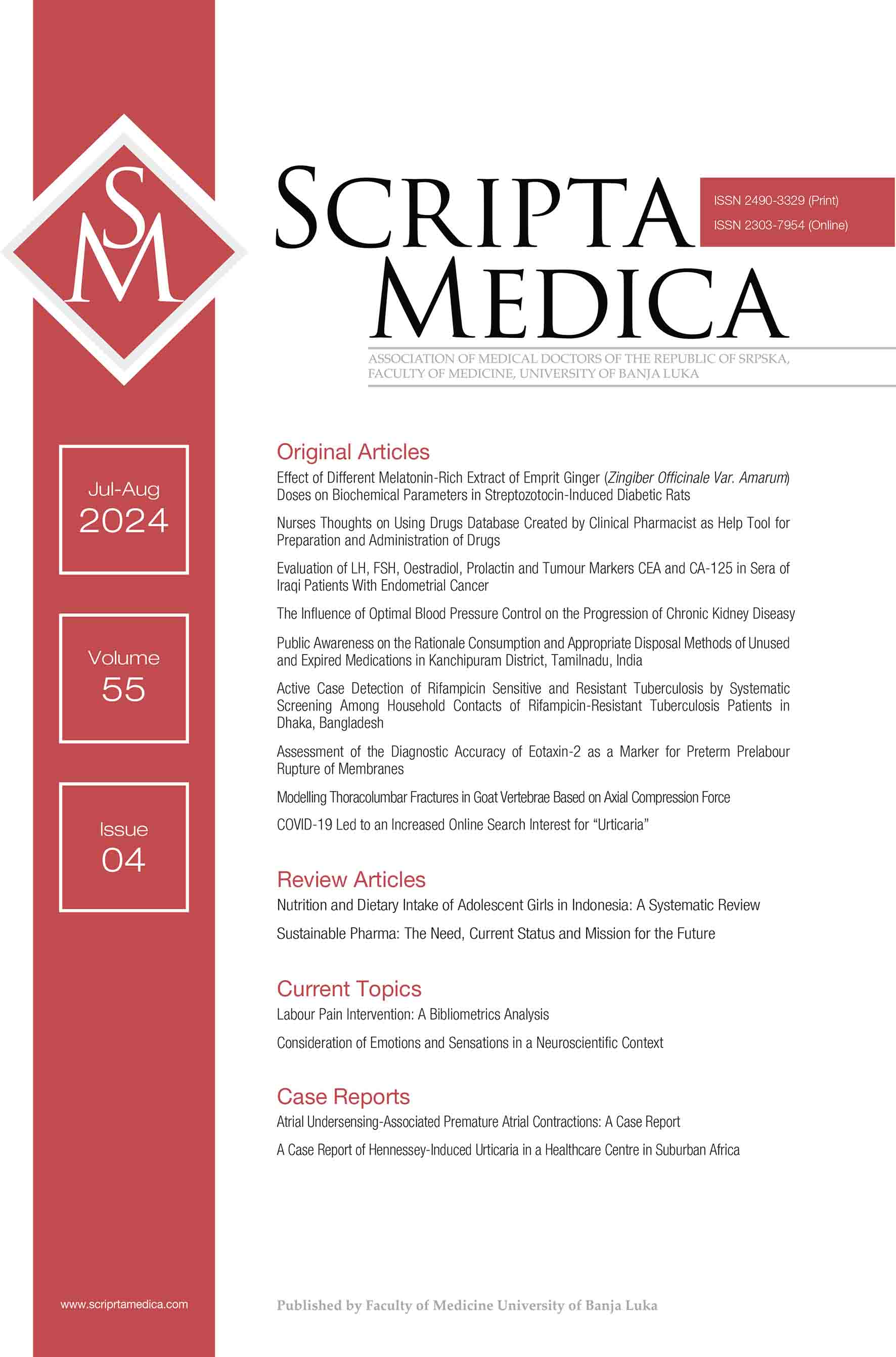Modelling Thoracolumbar Fractures in Goat Vertebrae Based on Axial Compression Force
Sažetak
Background/Aim: A profound understanding of the biomechanics underlying thoracolumbar animal models has become important in spine research. Aim of this study was to analyse difference in thoracolumbar fractures based on height loss caused by axial compression force.
Methods: This in vitro study used a randomised post-test only control group design. This study used goat vertebrae to make thoracolumbar fracture models based on axial compression force. Samples were divided into three groups on a single vertebral body and three groups on a single function spinal unit (FSU). Axial compression force was applied to vertebrae and FSU, reducing height by 20 %, 40 % and 60 % in different test groups.
Results: This study showed that the crushing pressure in one vertebra was approximately 4565.76 ± 722.93 Pa, and in one FSU, it was approximately 5070.4 ± 703.74 Pa. Different fractures were seen based on height loss. In the 20 % loss group, nine types of wedge fractures were found. In the 40 % loss group, two types of wedge fractures and seven incomplete burst fractures were observed. The 60 % loss group had nine types of complete burst fractures in single corpus testing, two incomplete burst fractures and seven complete burst fractures in single FSU testing.
Conclusion: There were differences in fracture configurations in goat vertebrae based on the height loss due to compression force in the single corpus and FSU.
Reference
Rosenthal BD, Boody BS, Jenkins TJ, Hsu WK, Patel AA, Savage JW. Thoracolumbar burst fractures. Clin Spine Surg. 2018 May;31(4):143-51. doi: 10.1097/BSD.0000000000000634.
Kornberg ST, Brisson BA. Stabilization of the Thoracolumbar spine. In: Advanced Techniques in canine and feline neurosurgery. Hoboken, New Jersey: Wiley; 2023; pp. 109-123. doi:10.1002/9781119790457.ch12.
Zhang F, Liu J, He X, Wang R, Lu T, Zhang T, et al. Preclinical evaluation of a novel 3D-printed movable lumbar vertebral complex for replacement: in vivo and biomechanical evaluation of goat model. Biomed Res Int. 2021 Dec 10;2021:2343404. doi: 10.1155/2021/2343404.
Yoganandan N, Khandelwal P, Porwal V, Humm J, Banerjee A. Human thoracolumbar spine tolerance to injury and mechanisms from caudo-cephalad loading: a parametric modeling study. J Eng Sci Med Diagn Ther. 2021;4(1). doi:10.1115/1.4049523.
Guo LX, Li WJ. A biomechanical investigation of thoracolumbar burst fracture under vertical impact loads using finite element method. Clin Biomech. 2019;68:29-36. doi:10.1016/j.clinbiomech.2019.05.018.
Sartoretto SC, Uzeda MJ, Miguel FB, Nascimento JR, Ascoli F, Calasans-Maia MD. Sheep as an experimental model for biomaterial implant evaluation. Acta Ortop Bras. 2016;24(5):262-6. doi:10.1590/1413-785220162405161949.
Banstola A, Reynolds JNJ. The sheep as a large animal model for the investigation and treatment of human disorders. Biology (Basel). 2022;11(9):1251. doi:10.3390/biology11091251.
Tan E, Wang T, Pelletier MH, Walsh WR. Effects of cement augmentation on the mechanical stability of multilevel spine after vertebral compression fracture. J Spine Sur. 2016;2(2):111-21. doi:10.21037/jss.2016.06.05.
Shin DE, Lee Y, An HJ, Hwang TS, Cho JW, Oh J, et al. Trabecular structural difference between the superior and inferior regions of the vertebral body: a cadaveric and clinical study. Front Endocrinol (Lausanne). 2023;14. doi:10.3389/fendo.2023.1238654.
Younus A, Kelly A, Lekgwara P. An institutional review of percutaneous stabilization versus open stabilization of unstable thoracolumbar fractures. Interdiscip Neurosurg. 2020;22:100806. doi:10.1016/j.inat.2020.100806.
Patel P, Ajudiya A. Outcomes of traumatic thoracolumbar fractures managed with Pedicular screw fixation system: A study of 25 cases. Int J Orthop Sci. 2019;5(4):417-20. doi:10.22271/ortho.2019.v5.i4h.1709.
Sadiqi S, Verlaan JJ, Lehr AM, Chapman JR, Dvorak MF, Kandziora F, et al. Measurement of kyphosis and vertebral body height loss in traumatic spine fractures: an international study. Eur Spine J. 2017 May;26(5):1483-91. doi: 10.1007/s00586-016-4716-9.
Seo JY, Kwon YS, Kim KJ, Shin JY, Kim YH, Ha KY. Clinical importance of posterior vertebral height loss on plain radiography when conservatively treating osteoporotic vertebral fractures. Injury. 2017;48(7):1503-9. doi:10.1016/j.injury.2017.04.057.
Yüksel MO, Gürbüz MS, Gök Ş, Karaarslan N, İş M, Berkman MZ. The Association between sagittal index, canal compromise, loss of vertebral body height, and severity of spinal cord injury in thoracolumbar burst fractures. J Neurosci Rural Pract. 2016;07(S01):S057-61. doi:10.4103/0976-3147.196466.
Peev N, Zileli M, Sharif S, Arif S, Brady Z. Indications for nonsurgical treatment of thoracolumbar spine fractures: WFNS spine committee recommendations. Neurospine. 2021;18(4):713-24. doi: 10.14245/ns.2142390.195.
- Authors retain copyright and grant the journal right of first publication with the work simultaneously licensed under a Creative Commons Attribution License that allows others to share the work with an acknowledgement of the work's authorship and initial publication in this journal.
- Authors are able to enter into separate, additional contractual arrangements for the non-exclusive distribution of the journal's published version of the work (e.g., post it to an institutional repository or publish it in a book), with an acknowledgement of its initial publication in this journal.
- Authors are permitted and encouraged to post their work online (e.g., in institutional repositories or on their website) prior to and during the submission process, as it can lead to productive exchanges, as well as earlier and greater citation of published work (See The Effect of Open Access).

